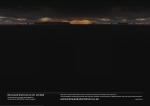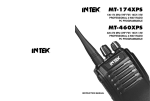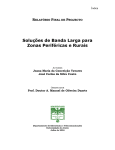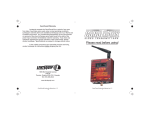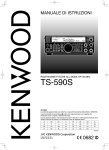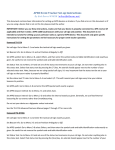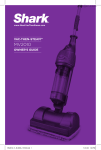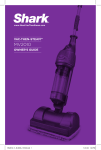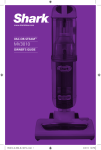Download Kenwood TS-990S Marine Radio User Manual
Transcript
HF/50MHz TRANSCEIVER TS-990S TS-990S H F/ 5 0 M H z TR A NSCEIVER For Real DX’ers 2 Legend and Innovation Actual size W18.11x H6.50 x D15.75 in *Projections not included. In the making for more than twenty years, the ultimate Contest / DX experience is here. Kenwood’s longawaited flagship model is equipped with the latest technology that embodies an entirely new HF standard. TS-990S 3 1973 TS-900 This all-band SSB transceiver made history with its state-of-the-art technology. 1982 TS-930 The world’s first Ham Radio HF transceiver equipped with a built-in automatic antenna tuner. 1985 TS-940 This HF transceiver offered the high dynamic range that won the struggle through the Cycle 22 pile-up. 1989 TS-950 Another world’s first, this HF transceiver came standard with a built-in DSP. Repeated innovation turns the tradition into a legend. External Speaker SP-990 Input :5 W 4 NEW 2013 TS-990 The TS-990S comes equipped with dual receivers for simultaneous reception on different bands, it also features narrow-band roofing filters on the main receiver in a full down-conversion configuration. The TS-990S achieves the highest basic reception performance of any radio in the TS series, through the careful selection of circuits, components and accelerating analysis using triple DSP configuration. Also, thanks to the dual TFT display and superior panel layout, it achieves both comfortable visibility and operability. Our top-of-the-line transceiver is for all radio operators who love HF. HF/50 MHz Transceiver TS-990S NEW Output:200 W 5 The dual receivers facilitate reception on different bands. The main receiver is the highest quality receiver among the TS-900 series, thanks to its down-conversion configuration, newly developed mixer, and five types of roofing filters. This highest quality transceiver will show its true metal in contests, and fierce pile-ups even with high-intensity signals. The TS-990S will surely satisfy any real DX’er. We have achieved down-conversion format for all amateur bands A key point in tapping maximum performance from the 1st mixer in actual operation (say, CW operation) is to prevent the outflow of unnecessary signals, other than the target signal, from the mixer to the subsequent stage. This is because it can tap the maximum performance of the digital IF filter using the DSP in the final IF stage. The TS-990S main receiver employs a 1st IF frequency 8.248 MHz down-conversion format. It achieves superior close-in dynamic range unattainable through conventional up-conversion formats. Even if the interference is a close-in frequency, the receiver maintains a relatively flat dynamic range, which you can tune without losing your target signal. Comparison 3rd order Intercept Point characteristics 50.00 40.00 Intercept Point [dBm] Overwhelmingly the highest quality receiver in the TS series. 30.00 20.00 10.00 0.00 -10.00 -20.00 TS-990S Our old model 1 10 100 Interfering wave separation [kHz] frx=14.2 MHz,PRE AMP OFF,BW 500 Hz,MODE CW The horizontal axis shows separation of the target signal by interfering signal frequencies (two waves). At a frequency of 10 kHz, interference 1 refers to reception frequency + 10 kHz, and interference 2 refers to reception frequency + 20 kHz. The newly developed mixer contributes to achieving +40 dBm IP3 In place of the Double Balanced Mixer, which uses the J-FET, we have installed the newly developed Double Balanced Grounded Switch Type in the 1st mixer circuit, which is the heart of the main receiver. The transceiver is also equipped with a pre selector function (works on HF amateur band) that varies its tuning frequency in tandem with the receiver frequency. It effectively dampens interference from strong signals that cannot be minimized through bandpass filters on dedicated amateur bands. Furthermore, we have achieved a +40 dBm class of third-order intercept point for the signal path of the 1st mixer, based on select circuits and components, employing large core toroidal coils for protecting against distortion from large input signals, as well as using relays for the signal switching. RF BPF ATT through 0/6/12/18 dB Pre Selector Pre Selector 160m BAND Amplitude (dB) 0 Main Receiver 6 -20 -40 -60 -80 -100 0.0 1.0 2.0 3.0 4.0 5.0 Frequency (Hz) Amateur Band RF BPF Pre Selector feature Transformer feedback RF Amp Main receiver HF/50MHz TRANSCEIVER TS-990S The transceiver uses the down-conversion method on all amateur bands, and features five types of High-IP roofing filter. Narrow bandpass widths selectable are 500 Hz and 270 Hz for CW operation, 2.7 kHz for SSB and 6 kHz and 15 kHz, which are suitable for AM/FM. These filters are automatically selected in tandem with DSP-based settings. Of course, manual switching is possible as well. CH1 B/R log MAG CH2 B/R log MAG High C/N levels are realized by dividing high frequencies using the newly developed VCO frequency division 1st local oscillator The TS-990S Local Oscillator Circuit is an independent configuration that combines the main receiver and VCO Frequency Division/DDS, the sub-receiver, DDS, transmitter and conventional PLL, with the targeted signal system. The newly developed VCO frequency division format is used for the 1st local oscillator of the main receiver. The device achieves favorable C/N characteristics that rival the DDS direct format, and relatively spurious-free local oscillation signals that are characteristic of the PLL format, by oscillating and dividing the VCO at higher frequencies than the intended frequency. It is possible to convert it to 1st IF in a pure state without leaking the target signal as noise by reducing static noise from the local oscillator and increasing the C/N ratio. 10 dB/ REF 0 DB 10 dB/ REF 0 DB Roofing Filters 270 Hz TS-990S MAIN Local OSC C/N 0 14.1 MHz 1.83 MHz -10 -20 -30 Phase Noise [dBc/Hz] The newly developed narrow-band High-IP roofing filters show their true value by cutting adjacent unwanted signals -40 -50 -60 -70 -80 -90 -100 -110 -120 -130 -140 -150 -160 1,000 100 10,000 100,000 Offset Frequency [Hz] Main receiver 1st Local Oscillator C/N Main receiver characteristic example (20m/160m) TS-990S MAIN BAND FRONT-END 500 Hz AMP Main reception unit 1st Local Oscillator Block Diagram Divider 1/N 1st Mixer through 2.7 kHz through IF BW 100 Hz 6 kHz Pre Amp PLL 96.48~ 127.48~ 107.48 MHz 138.992 MHz 1.8/3.5/5M ... N=10 7M ... N=8 14/18/21/ 24M ... N=4 AMP (other than these, DDS Direct) DDS IC AD 9951 10 dB/ REF 0 DB 10 dB/ REF 0 DB Comes equipped with ±0.1 ppm TCXO, which combines high stability and energy saving 15 kHz IF BW 100 Hz SWP 8.6 sec SPAN 3.5 kHz SPAN 100 kHz Roofing filter-characteristic example BW=500 Hz 1st Mixer PLL 115.48~ 128.992 MHz Roofing filter-characteristic example BW=270 Hz CH1 B/R log MAG CH2 B/R log MAG Post Amp SWP 8.6 sec SPAN 2 kHz SPAN 100 kHz DDS 82.78~ 92.48 MHz The standard equipment includes a TCXO (TemperatureCompensated Crystal Oscillator), which stabilizes frequencies at ±0.1 ppm as the standard signal source. Unlike OCXO (Oven Controlled Crystal Oscillator), which requires warm-up time, this device can start up quickly even from the power-off position, while maintaining a high level of stability. It is in compliance with European energy-saving standard Lot 6. Power consumption in stand-by energy-saving mode is less than 0.5 W. A BNC connector on the rear panel provides 10 MHz reference I/O. Mode Phantom load Start-up time Stand-by power saving Or less 0.5 W Approx. 40 seconds Normal Approx. 20 W Approx. 5 seconds 7 HF/50MHz TRANSCEIVER TS-990S Sub receiver Innovation spurred by digital technology has revolutionized the Kenwood sound. An already legendary Sub-receiver supports dual reception. Even after using narrow bandwidth filters for long periods of time, it is still easy to hear and less tiring to listen to. Two attractive features of simultaneous In addition to introducing AGC control using dedicated DSP, reception on different bands are that we have further refined the Kenwood sound and reception sound quality transmitted you can easily check the condition on by radio operators worldwide by innovating the analog AGC unit other bands and still easily handle and installing numerous interference and noise elimination functions. split-operation. Such innovations have given new life to Kenwood’s legendary sound. Sub Receiver The sub-receiver incorporates the TS-590S receiver Down-conversion occurs on the 160m/80m/40m/20m/15m bands* The sub-receiver features performance that has exceeded its class since going on sale, thus further refining this popular receiver on the TS-590S. Because this is particularly the case on the front end, where it employs circuit configuration that makes down-conversion possible on the leading five amateur bands, it can be used in actual operation despite being just a sub-receiver. more or less flat dynamic range even if interference impinges on your reception frequency, thanks to superior close-in dynamic range properties. You can clearly catch signals under conditions made problematic by strong close-in interference signals. * The IF bandwidth for 160m/80m/40m/20m/15m bands is (SSB/CW/FSK/PSK) for frequency levels 2.7 kHz or below. Roofing filters, 500 Hz, 2.7 kHz Frequencies of 500 Hz and 2.7 kHz are standard for sub-receiver roofing filters. You can maintain a 8 Triple DSP HF/50MHz TRANSCEIVER TS-990S Kenwood continues to provide quality sound transmission that is unattainable through analog circuits. By installing the world-premiere DSP in the TS-950 and achieving IF AGC control on the TS-870, our experience has led to the use of three DSP units, one on each major block of the TS-990S. By distributing the signal processing of the main IF, band scope, and sub-IF, we have realized ample digital signal processing power. (FM mode is AF DSP processing.) Extensive interference elimination and noise reduction functions IF filter bandwidth variability Band elimination filter function You can vary DSP filter bandwidth and eliminate extensive interference depending on use and condition. You can operate it as a HI CUT/LOW CUT function in SSB/AM/FM mode, and WIDTH/SHIFT function in CW/FSK/SSB-DATA transmission mode. The filter is capable of varying the stopband bandwidth and the amount of loss. When signals that interfere with the target signal multiply, this is a convenient funcBand Elimination Filter 0 tion for operations -20 such as dampen-40 ing interference -60 signals, even if it -80 cuts down some of -1,000 -500 0 500 1,000 Frequency (Hz) the target signal. WIDTH SHIFT If the interference is on one side only, you can shift the central frequency without changing bandwidth. You can avoid neighboring signals by varying the bandpass width. WIDTH SHIFT Intended signal For main IF DSP, transmission unit ADSP-21363 clock @333 MHz The reception sound quality of SSB and CW is not solely determined by audio frequency and filter delay properties. AGC characteristics play a very RX IF Analog AGCV IF ADC SOFT-ATK CONT Digital NB AGC DET AGCV DAC AGC DET OUT Band ATK/REL Manager The noise blanker function (NB1/NB2) is equipped with digital/analog 2 format For sub IF DSP, every kind of signal processing For band scope ADSP-21363 clock @333 MHz ADSP-21369 clock @260 MHz Advanced AGC control, fusing together digital and analog IF AGC control block diagram Target signal IF Filter AutoManual Notch Band Elimination Filter significant role as well. The opinion of many of our fans that “even for long periods of time they never get tired of listening” is due to the characteristics of Kenwood’s AGC. The Demod TS-990S goes a long way RX Audio in helping further refine the AGC DET Kenwood sound by innovating not only the AGC control algorithm on the DSP but also the analog AGC unit as well. The sound quality of the built-in speakers is largely determined by the chassis structure. With the TS-990S, we have been able to minimize unnecessary chassis vibration through multiple simulations from the conceptual phase. The Kenwood sound is supported not ϕ77 mm only by circuits and DSP but also by exact chassis design. Built-in speaker IF filter A/B/C one-touch switch instantly It is possible to preset a maximum of three IF filter bandwidths and switch instantly at any time. Set for narrow or wide, such a function is convenient for competitions requiring quick operations. Top plate oscillation simulation example Equipped with an analog noise blanker (NB1) which is considered effective against weak noise, and a digital noise blanker (NB2). Choose the NB1 or NB2 based on noise type and reception condition. With NB1, stable noise reduction is possible without depending on reception bandwidth. NB2 is effective against noise that cannot be tracked by an analog noise blanker. Plus, both the NB1 and NB2 can be used simultaneously with the TS-990S. DSP-based noise reduction function (NR1/NR2) IF notch You can eliminate overpowering interference signals with a notch filter and catch intended weak signals. You can switch between the IF auto notch and the manual notch that IF Manual Notch BW 400 Hz / 800 Hz 0 can be changed -20 manually, depend-40 ing on the state of -60 interference. -80 Amplitude (dB) Exacting chassis design for realizing quality sound Amplitude (dB) Equipped with dedicated DSP for the main receiver, sub-receiver, and band scope DSP / IF filter -1,000 -500 0 500 Frequency (Hz) 1,000 The device is also equipped with two types of noise reduction format—NR1 and NR2. An optimal noise reduction format is applied to each reception mode for NR1. And for NR2, SPAC method is applied which is more effective in CW operation. < Other extensive interference elimination and noise reduction functions > Beat cancel function (BC1/BC2) The beat cancel function is effective against relatively weak, multiple beats, whereas the IF auto notch is effective against strong beats. Audio peak filter You can vary bandpass width of pitch tone when there are carrier receptions like CW and FSK. FSK is compatible with mark and space frequencies. 9 Transmission unit /cooling HF/50MHz TRANSCEIVER TS-990S Transmitter performance, featuring high-scale specifications, can withstand long periods of operation at full power. Operating stably even when continually working over long periods of time, such as in competitions. Built-in automatic antenna tuner capable of high-speed operation The built-in automatic antenna tuner is a preset type that covers amateur band frequencies ranging from 160m~6m, and is completely operable during receive. The tuner is capable of rapid QSY based on instantaneous band change, using a relay system known for high-speed operations. The relays, capacitors, and inductors use largesized components that are able to bear the 200 W output. ANT 1 2 3 4 RX OUT MAIN BAND ANT Selector RX AT It is outfitted with four antenna terminals, which can be set independently on amateur bands, whether main band or sub band. The reception input and output terminals can be used for reception dedicated antennas, antenna output for external reception devices, and external BPF connections. It is usable with either the main band or the sub band. Transmit SUB BAND ANT Selector RX IN MAIN RX ANT OFF MAIN BAND RECEIVER ON TX SUB RX ANT OFF SUB BAND RECEIVER ON Transmission Unit Cooling system to send a sufficient volume of air to each unit High reliability design promises stable operation at 200 W The POWER MOS FET VRF150MP runs at 50 V in push-pull. You can obtain a stable output of 200 W on all bands. You achieve superior IMD properties by pursuing bias and matching conditions in order 3rd order TX IMD 14.2 MHz / 200 W -10 -30 Thermal Simulation Example To dissipate the heat of the 200 W final, we used swage fins instead of the conventional extruded aluminum fins. Using CAE analysis, we designed the optimal fin shape and size for heat dissipation. -50 -70 -90 10 dB / div 10 to fully exploit the FET attributes. Further, you can realize Kenwood’s distinctive tone by amplifying the clean modulated signal produced by DSP with an amplifier that exhibits excellent linearity. Cooling is very important to obtain a stable output of 200 W. Heat dissipation efficiency is increased in the TS-990S through a large fin-type aluminum heat sink. An independent variable-speed fan is provided for the switching power supply, final unit, and antenna tuner, cooling each unit with a sufficient air supply. The switching power supply and the final unit have twin cooling fans. Noise is reduced by controlling the fan speed according to the temperature. SPAN 10 kHz Dual Display HF/50MHz TRANSCEIVER TS-990S Sub band display monitors the target signal itself Fitted with dual TFT displays for an intuitive situational awareness. The combination of two displays, main and sub band, allows you to simultaneously monitor the target signal and the surrounding area with minimal eye movement. The 3.5” TFT sub band display is located above the main knob, which not only reduces eye movement in reading the frequency, but also allows you to monitor the target signal itself by displaying the demodulated audio spectrum. In addition, filter effects can be displayed on the easy-to-see sub band display, allowing for intuitive operation. You can switch the sub band display among the four different view modes below according to your intention. Magnified frequency display Normal display Dual frequency display Basic screen Dual frequency display Single frequency display with virtual dial Single frequency display Simultaneous display FSK mode Dual display Monitor the area surrounding the target signal with the main display Main display The main display shows basic information about the frequency, mode, meter, and other functions, as well as the on/off status of the other accessory functions. You can also view internal parameter settings and memory lists. In addition, it features a band scope function that allows you to monitor band status. Execute fast sweeps with FFT processing using DSP. Switch to different view modes such as waterfall and reception/transmission equalizer views. PSK mode When you are in the mood for a change, how about these display modes? Main display Touch-sensitive main screen Sub band display Main display example views Analog dial display Wide dial display (Reception specific) TS-930 type display Waterfall view Equalizer view Simply touch the main screen for quick QSY. TS-940 type display RTTY Reception view 11 HF/50MHz TRANSCEIVER TS-990S Comfortable operational performance that you can control at will. The panel layout, familiar to Kenwood users, allows for intuitive operation. It’s sure to win you over, increasing the accuracy of your operations and allowing you to develop greater familiarity with the equipment. Operability The new frequency function can be operated intuitively You can use the frequency function that switches legacy VFO A/VFO B by switching the main and sub band. Turn the sub band reception on and off using the RX key on top of the main knob, and switch between simplex and split using the TX key. A single glance at the LED lighting lets you know the current status. MAIN BAND RX / TX key SUB BAND RX / TX key The new split function allows you to use quick settings Similar to the legacy series, you can add functions via M S and M/S giving a dual-action quicksplit setup. 1. Hold down the Sub Band TX key, and the split LED will flash. 2. When the transmission frequency is set. To set 2UP, simply press 2 on the numeric keypad, and the sub band VFO will change +2 kHz from the main reception frequency; split set up is now complete. To set 1DOWN, press 0 and then 1 on the numeric keypad, and you can set increments of 1 kHz from±1~9 kHz. 2 . Searching for a transmis -sion frequency Operate the sub band knob to determine the transmission frequency, press the TX key, and setup is complete. Coarse adjustment is also possible by tapping a likely vacant frequency on the main scope. You can also input split and sub band reception states into memory Memory for a maximum of 120 channels is available. In addition to the repeater frequency, you can also preset beacons and transmission stations. You can easily call up the states of simultaneous dual reception using the dual channel memory. Number of Memory Channels Control 12 Standard Memory: 100 Channels Interval Specified Memory: 10 Channels Extended Memory: 10 Channels Useful functions HF/50MHz TRANSCEIVER TS-990S Conveniently located interference elimination controls of the sub-receiver Useful functions positioned around the main and sub band knob The dedicated sub-receiver has extensive interference elimination capability and is conveniently located to the right side of the main panel. Access the knobs and keys you need without hesitation. Share the use of main and sub band variable encoders by switching the operations object. An LED is lit when operating the sub band to prevent accidental operation (this can also be dedicated to the main encoder variable bandwidth). Other functions have been significantly upgraded in the TS-990S from the TS-590S, including band elimination filters, APF, mute, the addition of slope switching in the DSP IF FILTER, independent AGC OFF key, and simultaneous use of NB1/NB2. Frequently used functions are centrally placed in the immediate vicinity of the main and sub band knob. Supporting quick operation for radio sporting. Switch to update mode and insert USB memory into the USB-A port on the front panel, and the update will automatically begin. Or access your USB memory from your PC by connecting your PC via USB cable to the USB-B port on the rear panel, switch to update mode, and a folder named TS-990 will appear on your computer. DATA mode supported by external I/O switching FIL/SEL: Preset the bandpass with 2 or 3 widths of the DSP IF filter for quick WIDE/NAR switching operations. CW T (CW Tune): Automatic tuning makes the target signal turn into pitch frequency at a press of the CW signal key. FINE: The frequency change unit of the tuning knob can be set to 1/10 of the original unit VOICE: The PF key is usually for voice transmission, but you can also assign a different function to it. LOCK: F. LOCK Key. Useful when used in combination with TF-SET. Sub-receiver with extensive interference elimination controls centered on the right side of the main panel. Firmware updates by USB Increased user-friendliness by placing two USB ports on the front panel We equipped the front panel with two USB ports, a key jack, microphone jack and a headphone jack. Use USB memory or a keyboard. There are a variety of I/O interfaces, including the microphone jack, analog audio input and output, USB audio interface, and optical digital interface. By combining DATA mode (1-3) with SSB/FM/AM modes, it is possible to easily switch between an external device for modulation and demodulation. Switch between DATA VOX function and mute for each modulated line. Transmit and receive DSP equalizers In addition to the legacy presets, up to a maximum of three user settings can be configured. You can store the equalizer settings used for each mode and enjoy a very comfortable rag-chew session with others. RX equalizer Remote control the TS-990S from your PC Using the ARCP-990 software (radio control software), you can control most functions from your PC. Control the memory channel, settings, and functions using your PC. Download the free software from the Kenwood website. ARCP-990 example views Kenwood SKY COMMAND SYSTEM II Enables full-duplex operation with improved functionality such as visual confirmation of HF frequency on the LCD panel. Control via TNC (AX.25) enables more access to HF functions: XIT, mode switching, split-frequency operations on/off, memory shift, and frequency step selection. The transporter sends out its pre-programmed call sign via CW every 10 minutes. Commander Transporter HF antenna COM connector MIC ø3.5 mm EXT SP Commander TH-D72A / TM-D710A 440 MHz /144 MHz Transporter TH-D72A / TM-D710A 440 MHz /144 MHz Equipped with voice guidance for frequencies, key control, and setting. You can also record and replay your message. TS-990S 440 MHz band Voice signals, Control signals 440 MHz band Confirmation of HF frequency Voice guidance / recording function HF Transceiver 144 MHz band HF receive audio *Kenwood SKY COMMAND SYSTEM II uses a pair of TH-D72A / TM-D710A transceivers. TS-990S is limited to the following functions in the operation of the current KSS. Operation Commander [A / B] in the TS-990S is equivalent to [M / S]. Memory channel is simplex operation only. Remote power On/Off is not available on Standby State Low Power Consumption mode. Control to the main band operation only. Note: Refer to applicable Amateur Radio regulations to check whether you are permitted to use this function. 13 Front/Back Panel HF/50MHz TRANSCEIVER TS-990S Front Panel Back Panel Headphone Jack (ϕ6.3 mm) Antenna Connector ×4 AC Power Supply Connector (3 Pin) Paddle Keyer (ϕ6.3 mm) RX IN Connector (RCA): Receive Only Antenna Terminal AT Connector (6 Pin): External Antenna Tuner Connection USB Connector (USB-B): PC Control, USB Audio RX OUT Connector (RCA): External Receiver Connection Terminal Keypad Jack (ϕ3.5 mm): Function Key Pad Connection Microphone Jack (8 Pin Metal Type) Key Jack (ϕ6.3 mm): For Paddle, Straight Key, and PC Keying ACC2 Connector (13 Pin DIN): Audio I/O and Other Accessories Connection Remote Connector (7 Pin DIN): Linear Amplifier Connection Meter Jack (ϕ3.5 mm): Analog Meter Connection Drive Connector (RCA): Drive Output Ground Terminal Standard External I/O Terminal (BNC): 10 MHz Front/Rear Panel 14 Dimensions Back Panel COM Connector (D-SUB 9 Pin): RS-232C Optical Connector Input Terminal (EIAJ Optical) 7.17 (7.91* ) 6.50 Front Panel 7.87 18.11 25.98 *At front leg up position Optical Connector Output Terminal (EIAJ Optical) External Speaker Jack 1 (ϕ3.5 mm) External Speaker Jack 2 (ϕ3.5 mm) TS-990S USB Connector (USB-B): PC Control, USB Audio 15.75 17.68 Display Connector (DVI-I): External Display Connection Terminal LAN Connector (RJ-45): PC Control, Time Correction (NTP) SP-990 11.81 12.05 Unit: in Options/Specifications HF/50MHz TRANSCEIVER TS-990S Main Options MC-90 Deluxe Desktop Microphone MC-43S Hand Microphone TS-990S Specifications MC-60A General Desk Microphone HS-5*1 Frequency range (Transmitter) Open-Air Deluxe Headphones Receiver 160m band 1.8 ~ 2.0 MHz 80m band 3.5 ~ 4.0 MHz 60m band 5.1675, 5.25 ~ 5.45 MHz 40m band 7.0 ~ 7.3 MHz 30m band 10.1 ~ 10.15 MHz 20m band 14.0 ~ 14.35 MHz 17m band 18.068 ~ 18.168 MHz 15m band 21.0 ~ 21.45 MHz 12m band 24.89 ~ 24.99 MHz 10m band 28.0 ~ 29.7 MHz 6m band 50.0 ~ 54.0 MHz Frequency range (Receiver) HS-6*1 Light Weight Headphones SP-990 External Speaker NEW ARCP-990 Radio Control Program NEW *Freeware Freeware available for download from Kenwood website starting late March, 2013 *1:HS-5 and HS-6 are monaural. ARHP-990 Radio Host Program We recommend using stereo headphones to fully utilize simultaneous dual reception function of the main unit. VFO: Continuous 30 kHz ~ 60 MHz Sub1*2 Sub2*3 Double superheterodyne Double superheterodyne Triple superheterodyne Intermediate frequency 1st IF 8.248 MHz 11.374 MHz 73.095 MHz 2nd IF (FM) 24 kHz / (455 kHz) 24 kHz 3rd IF (FM) - 0.2 μV (1.705 ~ 24.5 MHz) 0.13 μV (24.5 ~ 30 MHz) 0.13 μV (50 ~ 54 MHz) 6.3 μV (0.13 ~ 0.522 MHz) Sensitivity (TYP) AM (S/N 10 dB) 32 μV (0.522 ~ 1.705 MHz) 2 μV (1.705 ~ 24.5 MHz) Frequency stability Within ±0.1 ppm 32 °F~122 °F (0 °C ~ +50 °C) Antenna impedance 50 Ω Antenna tuner load range 16.7 Ω ~ 150 Ω Standard voltage AC 120 V (60 Hz) Image Rejection Ratio (50 MHz) 70 dB (60 dB) or less Supply voltage range AC 90 V ~ 132 V / 180 V ~ 264 V IF Rejection Ratio 70 dB or less Dimensions 1.3 μV (24.5 ~ 30 MHz) 1.3 μV (50 ~ 54 MHz) FM (12 dB SINAD) 0.22 μV (28 ~ 30 MHz) 0.22 μV (50 ~ 54 MHz) At transmit (maximum) 720 VA or less 2.4 kHz or more (-6 dB) SSB (LO:200 / HI:2800 Hz) 4.4 kHz or less (-60 dB) At receive (no signal) 120 VA or less CW, FSK, PSK (WIDTH:500 Hz) Usable temperature range 32 °F~122 °F(0 °C~+50 °C) Without projection W18.11 x H6.50 x D15.75 in( W460 x H165 x D400 mm) Include projection W18.11 x H7.17 x D17.68 in(W460 x H182 x D449 mm) Selectivity Approx. 54.01 lbs (24.5 kg) Transmitter 500 Hz or more (-6 dB) 1.2 kHz or less (-60 dB) 6.0 kHz or more (-6 dB) AM (LO:100 / HI:3000 Hz) 12 kHz or less (-50 dB) FM At front leg up position front panel :H7.91 in(201 mm) rear panel:H6.81 in(173 mm) Weight 24 kHz / (455 kHz) 4 μV (0.522 ~ 1.705 MHz) Mode Power consumption 10.695 MHz - 0.5 μV (0.13 ~ 0.522 MHz) SSB, CW, FSK, PSK (S/N 10 dB) A1A (CW), J3E (SSB), F1B (FSK), G1B (PSK), A3E (AM), F3E (FM) NEW *Freeware Freeware available for download from Kenwood website starting late March, 2013 0.13 ~ 30 MHz, 50 ~ 54 MHz*1 Main Circuit type 12 kHz or more (-6 dB) 25 kHz or less (-50 dB) XIT variable range ±9.999 kHz Notch filter attenuation 60 dB or more (Auto), 70 dB or more (Manual) Beat cancel attenuation 40 dB or more CW/SSB/FSK/ Output power PSK/FM (AM) 200 W (50 W) Audio output 1.5 W or more (8 Ω) Modulation SSB:Balanced, AM:Low Power, FM:Reactance Audio output impedance 8Ω Maximum frequency deviation (FM) wide: ±5 kHz or less, narrow: ±2.5 kHz or less HF (Harmonics) : -60 dB or less Spurious emissions HF (others) : -50 dB or less 50 MHz: -66 dB or less Carrier suppression -60 dB or less Unwanted sideband suppression -60 dB or less Transmit frequency response Within -6 dB (300 ~ 2700 Hz) Microphone impedance 600 Ω XIT variable range ±9.999 kHz *1 MAIN BAND: Spec. guaranteed in amateur band 160m through 6m *2 In 160m/80m/40m/20m/15m Amateur band, IF band width 2.7 kHz or less (SSB, CW, FSK, PSK) *3 Except in above *2 Internal beat may occur during amateur radio band reception depending on combination of main band and sub band frequencies of a main unit. Spurious signal other than reception signal may appear on band scope (waterfall view) too. 15 Communications Division Headquarters 3970 Johns Creek Court, Ste. 100 Suwanee, GA 30024, U.S.A. *Alterations may be made without notice to improve the ratings or the design of the device. *The photographic and printing processes may cause the coloration of the device to appear different from that of the actual device. www.kenwoodusa.com ADS#04513 Printed In USA
















